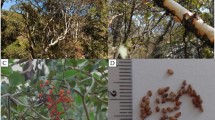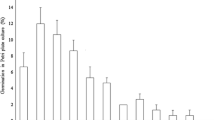Abstract
Germination ofLemna gibba L. seeds originating from two climatically different regions of Czechoslovakia: (1) South Bohemia, Jordán fishpond: (2) South Moravia, Nesyt fishpond, was examined under both laboratory and field conditions. The influence of water temperature on the rate of germination and the influence of different storage conditions on germination were assessed during 1972–1974. During the first year after ripening, all experimental treatments (i. e. germination at different water temperatures; storage in refrigerator and hibernation in the fishpond prior to germination) except the variant in which the seeds were kept in drought, resulted in roughly 100% germination. The rate of germination increased with increasing water temperature. The seeds lost their germination ability approximately after two years.
Similar content being viewed by others
Literature Cited
Arber, A. (1920): Water Plants.—Cambridge.
Hegelmayer, F. (1868): Die Lemnaceen, eine monographische Untersuchung.—Leipzig.
Hejný, S. [ed.], (1973): Ecosystem study on wetland biome in Czechoslovakia.—Czechosl. IBP/PT-PP Report, Třeboň, No. 3.
Adamcová-Bínová, J. (1968): PP/IBP initial level experiments in South Bohemia—Ann. Rep. Algol. Lab. Třeboň, 1967: 161–170.
Hillman, W. S. (1961): TheLemnaceae, or duckweeds.—Bot. Rev., New York 27: 221–287.
Jacobs, D. L. (1947): An ecological life history ofSpirodela polyrrhiza (greater duckweed) with emphasis on the turion phase—Ecol. Monogr., Durham, 17: 437–467.
Květ, J. [ed], (1973): Littoral of the Nesyt fishpond.—Studie, ČSAV, Praha, 15: 1–173.
Posner, H. B. etHillman, W. S. (1962): Aseptic production, collection and germination of seeds ofLemna perpusilla 6746.—Physiol. Plant., København, 15: 700–708.
Rejmánková, E. (1971): Vliv teploty a množství světelného záření na růst a produkci, okřehků (Lemna gibba L.,L. minor L. aSpirodela polyrrhiza (L.)Schleiden), (The influence of temperature and amount of light radiation on growth and production of duckweeds).—Ms., (Rigorosní práce Karlovy Univ., Praha, Depon. in Katedra Bot.).
Rejmánková, E. (1974): Biology of duckweed in a Pannonian fishpond.—Symp. Biol. Hung., Budapest, 15: 125–131.
Rostovcev, S. I. (1905): Biologo-morfologičeskij očerk rjasok.,—Moskva.
Sarukhán, J. (1974): Studies on plant demography:Ranunculus repens L.,R. Bulbosus L. andR. acris L.—Journ. Ecol., Oxford, 62: 151–177.
Sokal, R. R. atRohlf, F. J. (1969): Biometry.—San Francisco.
Author information
Authors and Affiliations
Rights and permissions
About this article
Cite this article
Rejmánková, E. Germination of seeds ofLemna gibba . Folia Geobot. Phytotax. 11, 261–267 (1976). https://doi.org/10.1007/BF02909473
Received:
Issue Date:
DOI: https://doi.org/10.1007/BF02909473




